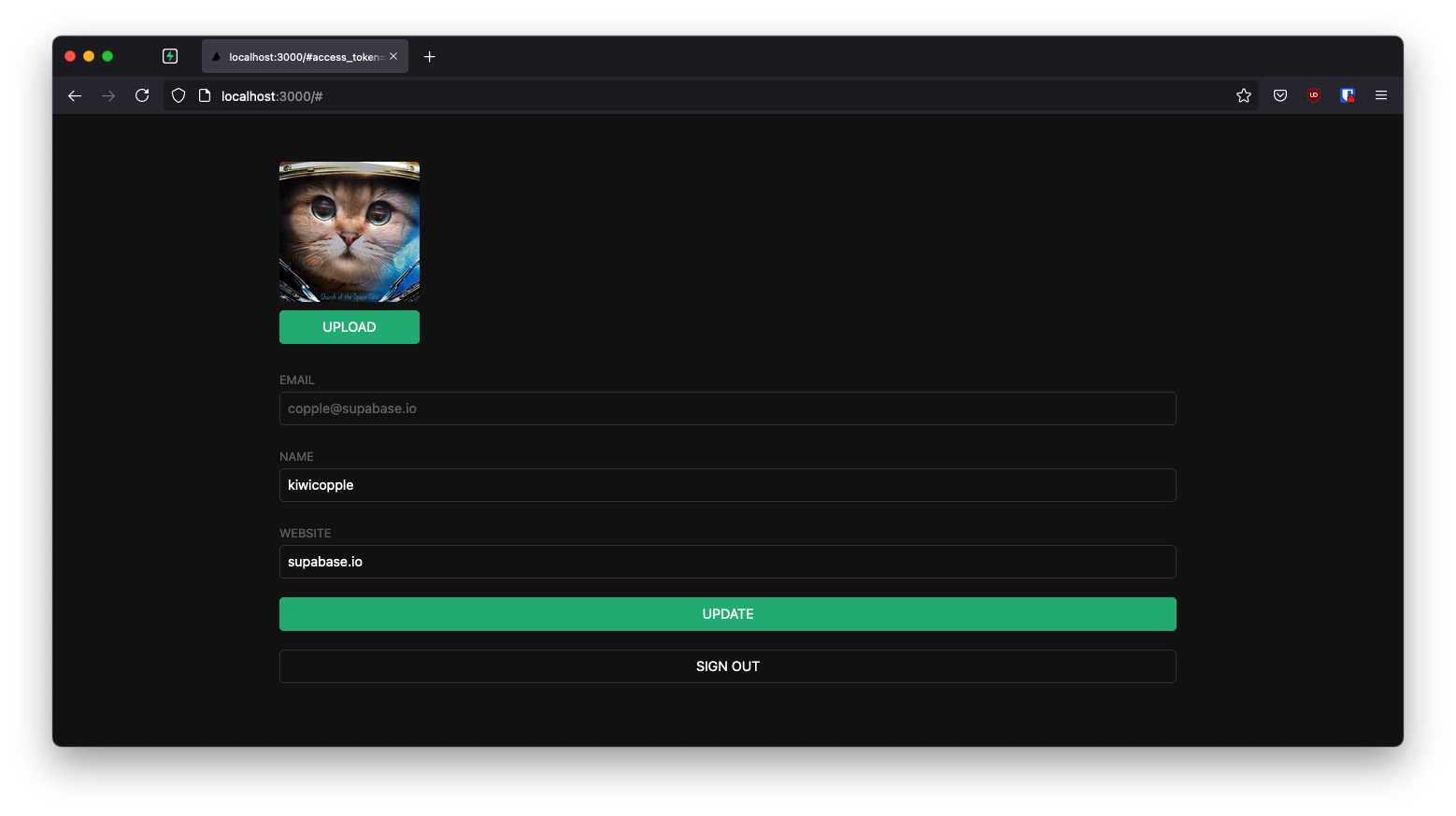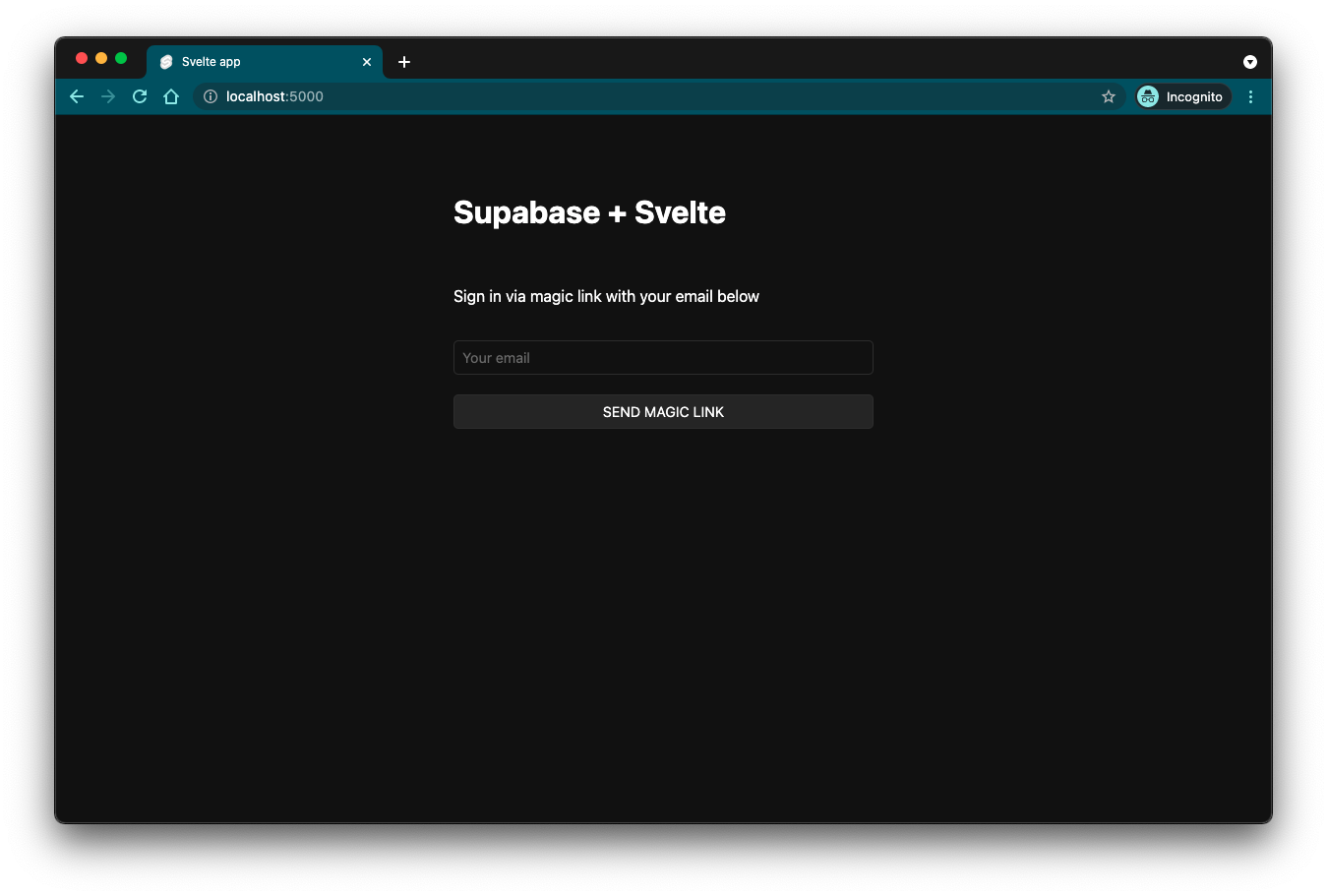Build a User Management App with Svelte
This tutorial demonstrates how to build a basic user management app. The app authenticates and identifies the user, stores their profile information in the database, and allows the user to log in, update their profile details, and upload a profile photo. The app uses:
- Supabase Database - a Postgres database for storing your user data and Row Level Security so data is protected and users can only access their own information.
- Supabase Auth - allow users to sign up and log in.
- Supabase Storage - allow users to upload a profile photo.

If you get stuck while working through this guide, refer to the full example on GitHub.
Project setup
Before you start building you need to set up the Database and API. You can do this by starting a new Project in Supabase and then creating a "schema" inside the database.
Create a project
- Create a new project in the Supabase Dashboard.
- Enter your project details.
- Wait for the new database to launch.
Set up the database schema
Now set up the database schema. You can use the "User Management Starter" quickstart in the SQL Editor, or you can copy/paste the SQL from below and run it.
- Go to the SQL Editor page in the Dashboard.
- Click User Management Starter under the Community > Quickstarts tab.
- Click Run.
You can pull the database schema down to your local project by running the db pull command. Read the local development docs for detailed instructions.
1supabase link --project-ref <project-id>2# You can get <project-id> from your project's dashboard URL: https://supabase.com/dashboard/project/<project-id>3supabase db pullGet API details
Now that you've created some database tables, you are ready to insert data using the auto-generated API.
To do this, you need to get the Project URL and key from the project Connect dialog.
Changes to API keys
Supabase is changing the way keys work to improve project security and developer experience. You can read the full announcement, but in the transition period, you can use both the current anon and service_role keys and the new publishable key with the form sb_publishable_xxx which will replace the older keys.
In most cases, you can get the correct key from the Project's Connect dialog, but if you want a specific key, you can find all keys in the API Keys section of a Project's Settings page:
- For legacy keys, copy the
anonkey for client-side operations and theservice_rolekey for server-side operations from the Legacy API Keys tab. - For new keys, open the API Keys tab, if you don't have a publishable key already, click Create new API Keys, and copy the value from the Publishable key section.
Read the API keys docs for a full explanation of all key types and their uses.
Building the app
Start building the Svelte app from scratch.
Initialize a Svelte app
You can use the Vite Svelte TypeScript Template to initialize an app called supabase-svelte:
1npm create vite@latest supabase-svelte -- --template svelte-ts2cd supabase-svelte3npm installInstall the only additional dependency: supabase-js
1npm install @supabase/supabase-jsFinally, save the environment variables in a .env.
All you need are the API URL and the key that you copied earlier.
1VITE_SUPABASE_URL=YOUR_SUPABASE_URL2VITE_SUPABASE_PUBLISHABLE_KEY=YOUR_SUPABASE_PUBLISHABLE_KEYNow you have the API credentials in place, create a helper file to initialize the Supabase client. These variables will be exposed on the browser, and that's fine since you have Row Level Security enabled on the Database.
src/supabaseClient.ts
1import { createClient } from '@supabase/supabase-js'23const supabaseUrl = import.meta.env.VITE_SUPABASE_URL4const supabasePublishableKey = import.meta.env.VITE_SUPABASE_PUBLISHABLE_KEY56export const supabase = createClient(supabaseUrl, supabasePublishableKey)App styling (optional)
Optionally, update the CSS file src/app.css to make the app look nice.
You can find the full contents of this file on GitHub.
Set up a login component
Set up a Svelte component to manage logins and sign ups. It uses Magic Links, so users can sign in with their email without using passwords.
src/lib/Auth.svelte
1<script lang="ts">2 import { supabase } from "../supabaseClient";34 let loading = $state(false);5 let email = $state("");67 const handleLogin = async () => {8 try {9 loading = true;10 const { error } = await supabase.auth.signInWithOtp({ email });11 if (error) throw error;12 alert("Check your email for login link!");13 } catch (error) {14 if (error instanceof Error) {15 alert(error.message);16 }17 } finally {18 loading = false;19 }20 };21</script>2223<div class="row flex-center flex">24 <div class="col-6 form-widget" aria-live="polite">25 <h1 class="header">Supabase + Svelte</h1>26 <p class="description">Sign in via magic link with your email below</p>27 <form class="form-widget" onsubmit={(e) => { e.preventDefault(); handleLogin(); }}>28 <div>29 <label for="email">Email</label>30 <input31 id="email"32 class="inputField"33 type="email"34 placeholder="Your email"35 bind:value={email}36 />37 </div>38 <div>39 <button40 type="submit"41 class="button block"42 aria-live="polite"43 disabled={loading}44 >45 <span>{loading ? "Loading" : "Send magic link"}</span>46 </button>47 </div>48 </form>49 </div>50</div>Account page
After a user is signed in, allow them to edit their profile details and manage their account.
Create a new component for that called Account.svelte.
1<script lang="ts">2 import { onMount } from "svelte";3 import type { AuthSession } from "@supabase/supabase-js";4 import { supabase } from "../supabaseClient";56 // ...78 interface Props {9 session: AuthSession;10 }1112 let { session }: Props = $props();1314 // ...1516 let username = $state<string | null>(null);17 let website = $state<string | null>(null);18 let avatarUrl = $state<string | null>(null);1920 onMount(() => {21 getProfile();22 });2324 const getProfile = async () => {25 try {26 loading = true;27 const { user } = session;2829 const { data, error, status } = await supabase30 .from("profiles")31 .select("username, website, avatar_url")32 .eq("id", user.id)33 .single();3435 if (error && status !== 406) throw error;3637// ...383940 if (data) {41 username = data.username;42 website = data.website;43 avatarUrl = data.avatar_url;44 }45 } catch (error) {46 if (error instanceof Error) {47 alert(error.message);48 }49 } finally {50 loading = false;51 }52 };5354 const updateProfile = async () => {55 try {56 loading = true;57 const { user } = session;585960 // ...6162 id: user.id,63 username,64 website,65 avatar_url: avatarUrl,66 updated_at: new Date().toISOString(),67 };6869 const { error } = await supabase.from("profiles").upsert(updates);7071 if (error) {72 throw error;73 }74 } catch (error) {75 if (error instanceof Error) {76 alert(error.message);77 }78 } finally {79 loading = false;80 }8182// ...8384</script>8586<form onsubmit={(e) => { e.preventDefault(); updateProfile(); }} class="form-widget">87 <div>Email: {session.user.email}</div>88 <div>89 <Avatar bind:url={avatarUrl} size={150} onupload={updateProfile} />90 <label for="username">Name</label>91 <input id="username" type="text" bind:value={username} />92 </div>93 <div>94 <label for="website">Website</label>95 <input id="website" type="text" bind:value={website} />96 </div>97 <div>98 <button type="submit" class="button primary block" disabled={loading}>99 {loading ? "Saving ..." : "Update profile"}100 </button>101 </div>102 <button103 type="button"104 class="button block"105 onclick={() => supabase.auth.signOut()}106 >107 Sign Out108 </button>109</form>Launch!
Now that you have all the components in place, update App.svelte:
src/App.svelte
1<script lang="ts">2 import { onMount } from 'svelte'3 import { supabase } from './supabaseClient'4 import type { AuthSession } from '@supabase/supabase-js'5 import Account from './lib/Account.svelte'6 import Auth from './lib/Auth.svelte'78 let session = $state<AuthSession | null>(null)910 onMount(() => {11 supabase.auth.getSession().then(({ data }) => {12 session = data.session13 })1415 supabase.auth.onAuthStateChange((_event, _session) => {16 session = _session17 })18 })19</script>2021<div class="container" style="padding: 50px 0 100px 0">22 {#if !session}23 <Auth />24 {:else}25 <Account {session} />26 {/if}27</div>Once that's done, run this in a terminal window:
1npm run devAnd then open the browser to localhost:5173 and you should see the completed app.
Svelte uses Vite and the default port is 5173, Supabase uses port 3000. To change the redirection port for Supabase go to: Authentication > URL Configuration and change the Site URL to http://localhost:5173/

Bonus: Profile photos
Every Supabase project is configured with Storage for managing large files like photos and videos.
Create an upload widget
Create an avatar for the user so that they can upload a profile photo. Start by creating a new component:
src/lib/Avatar.svelte
1<script lang="ts">2 import { supabase } from "../supabaseClient";34 interface Props {5 size: number;6 url?: string | null;7 onupload?: () => void;8 }910 let { size, url = $bindable(null), onupload }: Props = $props();1112 let avatarUrl = $state<string | null>(null);13 let uploading = $state(false);14 let files = $state<FileList>();1516 const downloadImage = async (path: string) => {17 try {18 const { data, error } = await supabase.storage19 .from("avatars")20 .download(path);2122 if (error) {23 throw error;24 }2526 const url = URL.createObjectURL(data);27 avatarUrl = url;28 } catch (error) {29 if (error instanceof Error) {30 console.log("Error downloading image: ", error.message);31 }32 }33 };3435 const uploadAvatar = async () => {36 try {37 uploading = true;3839 if (!files || files.length === 0) {40 throw new Error("You must select an image to upload.");41 }4243 const file = files[0];44 const fileExt = file.name.split(".").pop();45 const filePath = `${Math.random()}.${fileExt}`;4647 const { error } = await supabase.storage48 .from("avatars")49 .upload(filePath, file);5051 if (error) {52 throw error;53 }5455 url = filePath;56 onupload?.();57 } catch (error) {58 if (error instanceof Error) {59 alert(error.message);60 }61 } finally {62 uploading = false;63 }64 };6566 $effect(() => {67 if (url) downloadImage(url);68 });69</script>7071<div style="width: {size}px" aria-live="polite">72 {#if avatarUrl}73 <img74 src={avatarUrl}75 alt={avatarUrl ? "Avatar" : "No image"}76 class="avatar image"77 style="height: {size}px, width: {size}px"78 />79 {:else}80 <div class="avatar no-image" style="height: {size}px, width: {size}px"></div>81 {/if}82 <div style="width: {size}px">83 <label class="button primary block" for="single">84 {uploading ? "Uploading ..." : "Upload avatar"}85 </label>86 <span style="display:none">87 <input88 type="file"89 id="single"90 accept="image/*"91 bind:files92 onchange={uploadAvatar}93 disabled={uploading}94 />95 </span>96 </div>97</div>Add the new widget
And then you can add the widget to the Account page:
1<script lang="ts">23 // ...45 import Avatar from "./Avatar.svelte";67 // ...89 } finally {10 loading = false;11 }1213 // ...1415 };1617 // ...1819 </div>20 <button21 type="button"22 class="button block"23 onclick={() => supabase.auth.signOut()}24 >25 Sign Out26 </button>27</form>At this stage you have a fully functional application!